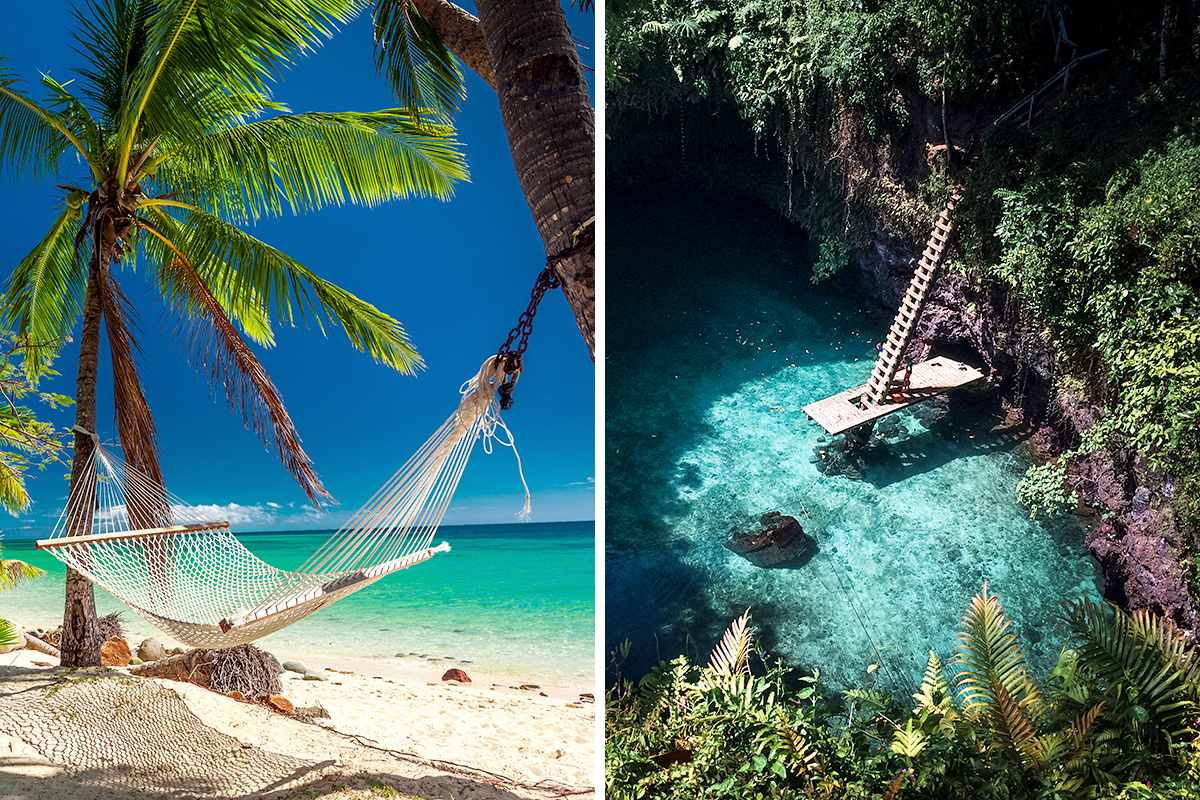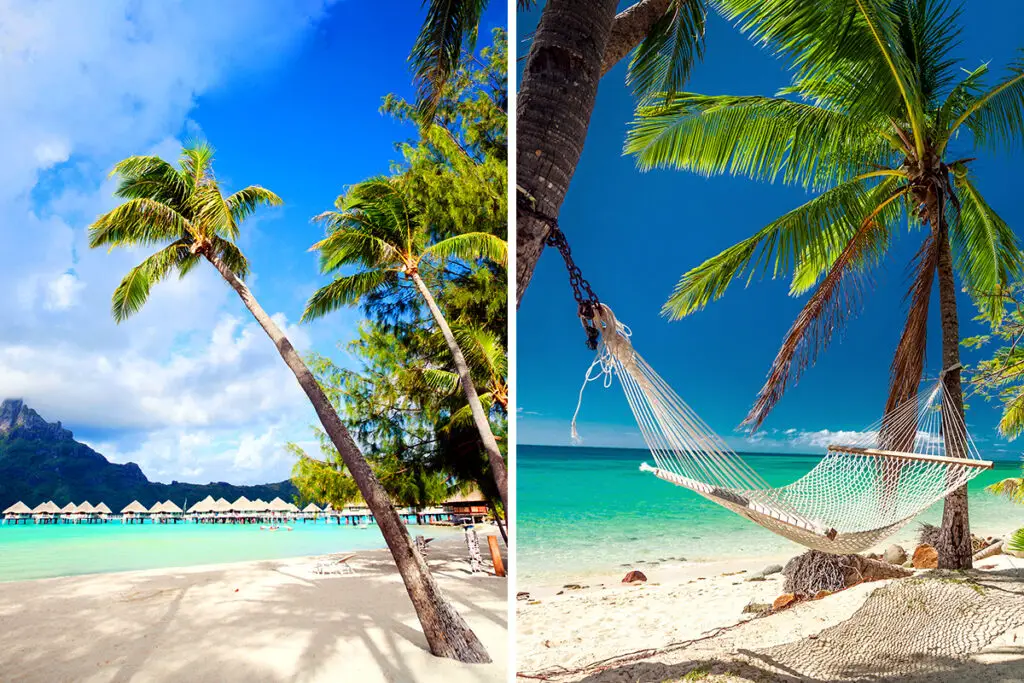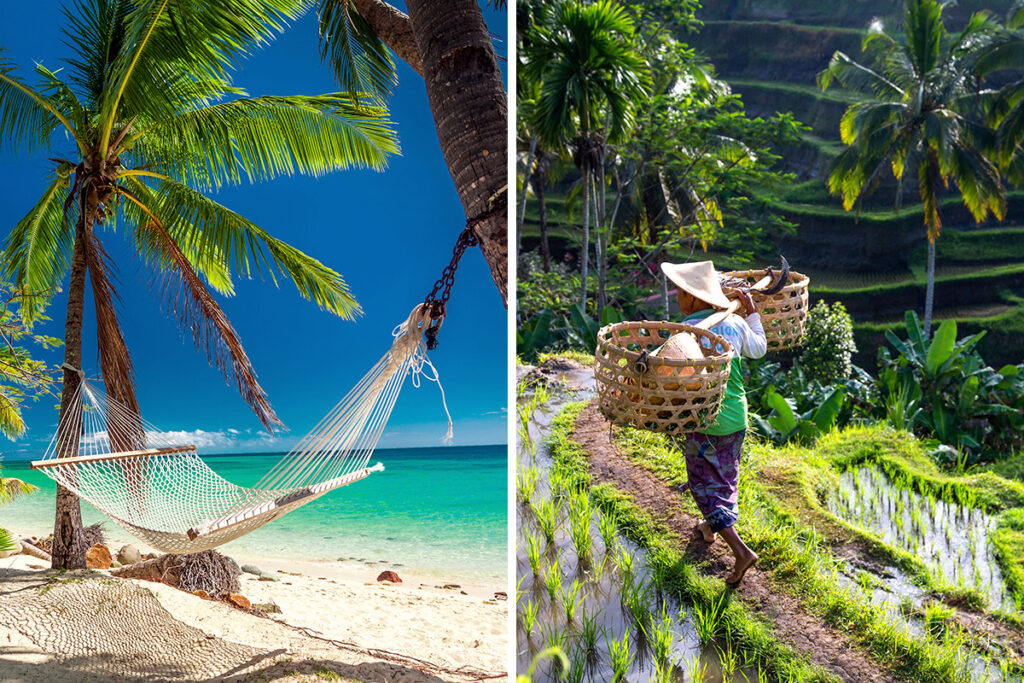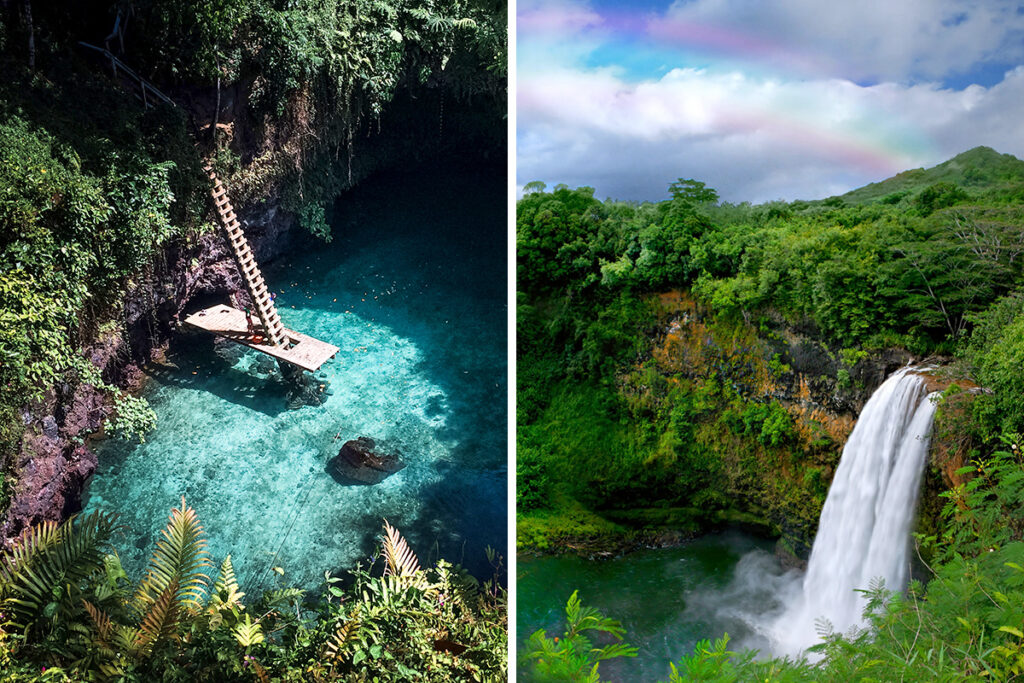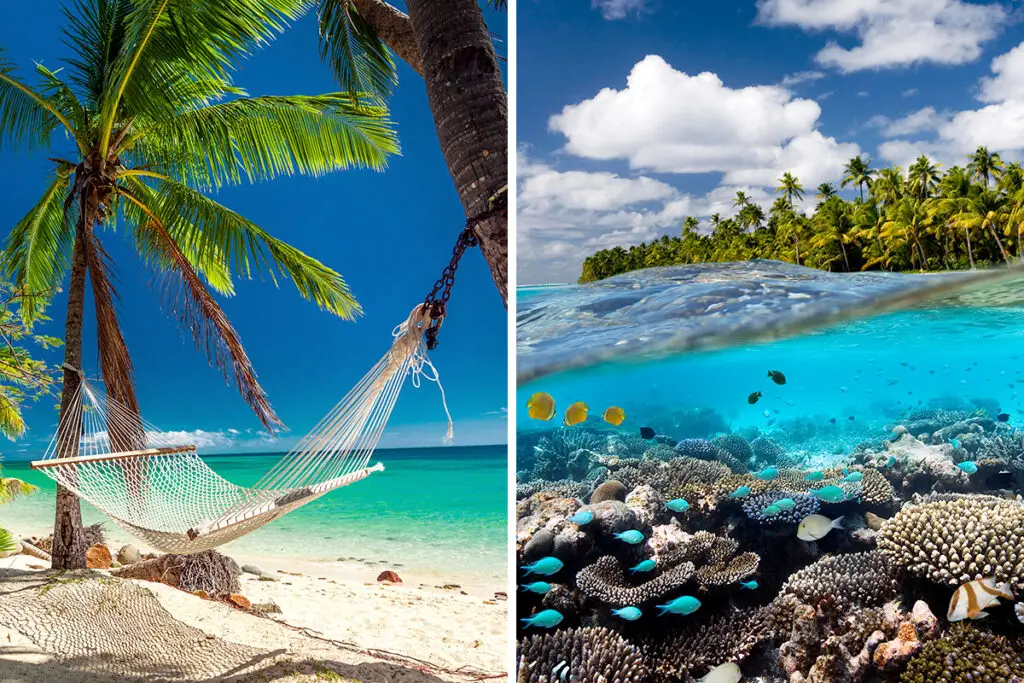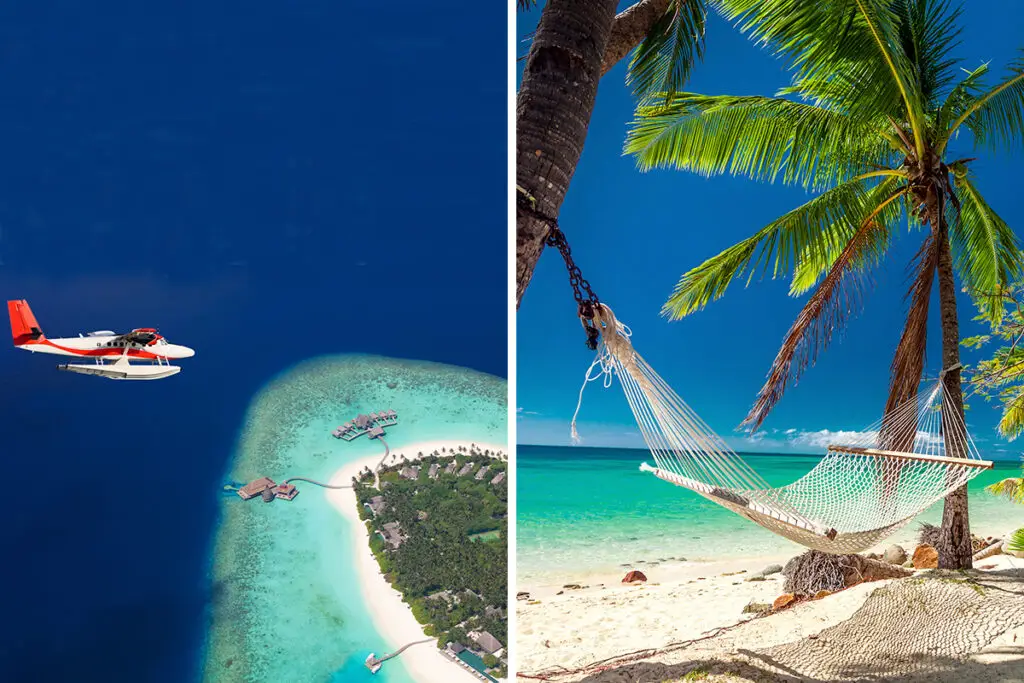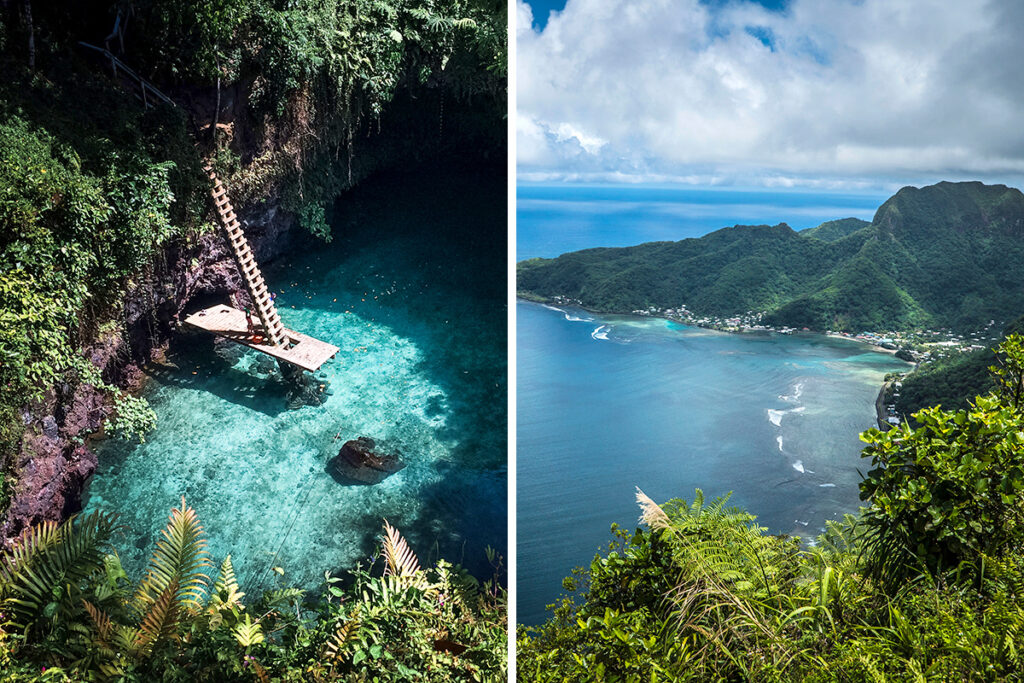Fiji is an archipelago consisting of several hundred islands. It is primarily known as a prime surf location with waves catering to surfers of all levels. Aside from that, Fiji is a good pick for people looking for an escape in one of its many private island resorts.
On the other hand, Samoa is a nature lover’s paradise. It features unspoiled landscapes with lush forests and crystal clear waters. Visitors have tons of nooks and crannies to explore and uncover.
Given their isolated location, Fiji and Samoa don’t get as many tourists. However, this doesn’t mean that Fiji and Samoa are not worth visiting. In fact, it’s the complete opposite! If you can’t decide between the two, this travel guide can help you.
Fiji
Fiji is a small island nation located in Oceania. Lying several thousand miles off the coast of New Zealand, Fiji is known for its wondrous beaches and grandiose mountains. Although relatively small, Fiji is actually an archipelago with more than 300 islands.
Despite its relatively isolated location, Fiji is a popular tourist attraction. It is particularly a famous summer and romantic getaway destination. With its numerous quaint islands, Fiji is perfect for relaxing vacations and honeymoons.
Fiji is comprised of two primary islands – Viti Levu and Vanua Levu. These two are the largest islands in the Fijian archipelago. Viti Levu houses Fiji’s capital city of Suva and features the towering 1,324-meter-high (4,344 ft) Mount Tomanivi. It is also home to the majority of Fiji’s total population.
Viti Levu is the main tourist hub of Fiji. It features the island’s international airport and not far from there are countless beach resorts and hotels. It also serves as the historical and cultural center of the island.
On the other hand, Vanua Levu is known as a tropical paradise. With pristine beaches all around and numerous islands to explore and discover. Vanua Levu also provides better access to Fiji’s more remote island groups. Over here, tourists can enjoy a quieter space and indulge in Fiji’s natural beauty.
What Makes Fiji Unique?
Endless Island-Hopping Experience
Since Fiji is an archipelago consisting of 333 islands, there is no better way to explore the nation than to hop from one island to another. Tourists can enjoy a wide range of activities in Fiji’s paradise islands—
One of the most famous options is the renowned Blue Lagoon Cruise. It starts at Port Denarau at Viti Levu and travels through the Yasawa and Mamanuca island groups. Tourists can opt for a 3-day-, 4-day-, or 7-day-long trip with varying itineraries. Regardless, the cruise only travels a maximum of 4 hours each day to provide visitors more time to explore the islands.
But aside from the Blue Lagoon cruise, there are several more islands worth visiting in Fiji. Denarau Island, where the cruise takes off, is a popular tourist hub. It’s a beautiful island with shopping centers, a world-class golf club, and high-end resorts.
The major island of Vanua Levu is a safe haven for nature lovers and outdoor enthusiasts. It features the lush Wasalit Nature Reserve with amazing hiking trails that offer panoramic views of Fiji.
Vanua Levu is also home to wondrous snorkeling and dive spots. There is the untouched and well-kept Namena Marine Reserve. The famous Rainbow Reef also lies off the southeastern coast of the island.
However, some tourist found their best experiences far from Fiji’s main islands. There are several private island resorts where tourists can enjoy a peaceful getaway. Wakaya Island and Matangi Island are popular among couples looking for a romantic escape.
The islands of Taveuni and Kadavu offer a more authentic Fijian experience. With less commercialized city centers, these islands are perfect for immersing in true Fijian culture. However, there are also amazing tourist attractions in these parts. There’s the Great Astrolabe Reef and the 60-foot-tall (18 m) Tavoro Waterfalls.
World-Class Surfing
Other than its white sand beaches, Fiji’s coasts have more to offer. Dubbed one of the best surf spots in the world, Fiji features amazing swells suitable for both beginner and expert surfers.
Given its location in the South Pacific Ocean, the islands in Fiji feature different waves and swells. Depending on where you are on the island, the waves can come in smaller breaks or towering barrels. Certain surf spots are perfect for beginners while some are best left for the experts and pros.
The Coral Coast off the southwestern end of Viti Levu features beginner-friendly waves. This includes Natadola Beach, The Beachhouse, and the Sigatoka Sand Dunes. There are also a handful of easier waves over the northern Mamanuca Islands. This includes the Desperations and the Swimming Pools over Namotu Island.
However, Fiji is more known for its challenging waves perfect for more experienced surfers. These epic waves can grow to mammoth sizes that enthusiasts long for.
The famous Cloudbreak over in the Mamanuca islands offers swells reaching up to more than 3 m (10 ft). The steep waves coming into the shallow reef create opportunities for surfers to barrel through.
Around the same area are the renowned Namotu Lefts and the Wilkes Passage. While swells don’t compare to the renowned Cloudbreak, these spots offer equally exciting waves. The Namotu Lefts is known for its fast-coming but relatively smaller 1 to 1.5 m (3 to 5 ft). On the other hand, the Wilkes Passage is perfect for long and fun rides.
Other popular breaks in Fiji include the Bula Bows over Qamea island, the beachfront swells at Natadola Bay, and the Suva Reef off the Suva Harbour.
Fijian Beauty and History
No trip to Fiji is complete without discovering the island’s long history and rich culture. There are tons of ways to learn about Fiji.
Get the chance to explore majestic temples or indulge in expansive museum collections. Visiting these tourist attractions will surely show you what Fiji is all about.
Fiji Museum
The quaint Fiji Museum is tucked within the Thurston Gardens in the capital city of Suva. It features a wide range of exhibits that showcases the island’s long and fascinating history.
Housed in a historic building from the 1970s, the museum features several galleries. The museum houses a vast collection of artifacts tackling the island’s pre- and Indo-Fijian history. It also has an art gallery featuring the work of renowned local artists, a bark-cloth gallery, and a natural history gallery.
Sri Siva Subramaniya Temple
The Sri Siva Subramaniya Temple is considered one of the most iconic landmarks on the island.
Located in the town of Nadi, the temple lies along the Nadi River and features distinct Dravidian architecture. An older temple has laid in this location in the 1920s but reconstruction was only completed in 1986.
Dedicated to the Hindu god of seasonal rains, the temple draws thousands of worshippers and tourists each year. It is also recognized as the largest Hindu temple in the Pacific region.
Garden of the Sleeping Giant and Sabeto Hot Springs
The Garden of the Sleeping Giant and Sabeto Hot Springs is one of Fiji’s hidden jewels. This tourist attraction is considered one of the best ways to appreciate the island’s lush natural beauty.
The 20-acre (8-ha) garden features native plants and a jungle that visitors can explore. However, the highlight of this well-landscaped garden is its vast collection of orchids that are more than 2,000 different types.
After exploring the massive garden, get the chance to dip in the renowned Sabeto Mud Pool. You can coat and lather yourself with warm mud or soak in a hot spring that is said to provide amazing health benefits.
Exciting Eco-Adventures
Fiji is a tropical island blessed with majestic natural landscapes. From grandiose mountains to wondrous coastlines, tourists can take their adventures deep in the forest or under the ocean.
Bouma National Heritage Park
Located on the island of Taveuni, the Bouma National Heritage Park is one of the largest in Fiji. Encompassing a total of 57 sq. mi (150 sq. km), the park protects roughly 80% of the lush Taveuni Island.
Tourists can venture into the national park with its numerous hiking trails. However, the park’s primary attraction is the famous Tavoro Waterfalls.
The Tavoro Waterfalls feature a series of falls accessible through a well-marked and cultured path. The first waterfall in the series stands at a stunning 75 ft (24 m) high. It is a popular site with a clear natural pool at the bottom and only requires a short 10-minute hike.
Although smaller, the Middle waterfall offers a larger natural pool to swim in. However, it takes a longer 30-minute to 40-minute trek up the mountain.
The Upper waterfall, the third of the Tavoro series, lies deeper in the forest. Visitors need to hike for more than an hour to reach the falls. Despite this, many love the Upper falls because of its much secluded and serene atmosphere.
Navua River
The Navau River is a 40-mile-long (65 km) river system that passes through the island of Viti Levu. Considered one of the most popular attractions on the island, tourists can enjoy a wide array of activities in the river.
Aside from the usual dip in the water, Navau River is famous for its scenic boat trip, casual kayak rides, as well as wild river rafting. Part of the river features calm waters where visitors can take a leisurely boat or kayak ride. However, the upper end of the river is known for its river rapids where tourists can pass through gorges and brave strong currents.
Samoa
Samoa is known for its beautiful landscapes and rich culture. Covering roughly 1,097 sq mi (2,842 sq. km), the small island nation is characterized by soaring peaks, deep forests, alluring beaches, and rugged coasts.
The islands of Upolu and Savai’i make up the island nation of Samoa. The larger Savai’i is known for its mountainous terrain with thick rainforests. The towering 6,095-foot-high (1,858 m) Mt. Sisiile lies at the center and dominates the island’s landscape.
Although smaller, the island of Upolu serves as the main tourist and economic center of Samoa. It is home to roughly 75% of Samoa’s total population and is where the capital city of Apia is located.
Sitting halfway between New Zealand and Hawaii, Samoa is a popular tourist destination for summer vacations. It has tons of beaches and several mountains for tourists to conquer and explore. The island is also famous for its long history and well-kept culture and traditions.
What Makes Samoa Unique?
The Historical and Cultural City of Apia
The capital city of Apia lies along the central northern coast of Samoa’s Upolu island. It sits at the foot of Mount Vaea and is home to roughly 36,000 people.
Aside from being Samoa’s capital, Apia is only the designated city in the whole nation. Because of its prime location, Apia witnessed much of Samoa’s history. Several historic sites and cultural attractions in the city of Apia mark and celebrate Samoa’s growth and progress over the years.
Museum of Samoa
The museum of Samoa serves as the island’s national museum. First established in 1999, the museum was originally housed in the Old Courthouse in Apia but was later moved to a new location in Malifa, Apia. It is home to several exhibits celebrating Samoan history, culture, and life.
Although relatively small, the museum aims to preserve and protect evidence of the island’s history. It features a collection of more than 900 artifacts, most of which were donated by locals. Aside from this, the museum also exhibits old photographs and documentaries which aim to teach and celebrate Samoan life.
Robert Louis Stevenson Museum
Robert Louis Stevenson was a renowned Scottish author and poet who made Samoa his home during the latter years of his life. His residential estate, the Vailima, is another cultural attraction in the city.
Established in 1969, the RLS Museum was founded by bibliophile Norman Strouse. The museum currently features three different collections. This includes the Norman H. Strouse Collection, the Angel Collection, and the Austin Strong Collection.
These feature hundreds of Stevenson’s life work including books, articles, and news reports. All of these aim to celebrate Stevenson as an esteemed writer and a well-respected member of the Samoan community.
Samoa Cultural Village
The Samoa Cultural Village is a cultural center located along the stretch of the Apia Harbor. Set in an open field by the coast, the cultural village offers an amazing opportunity to experience Samoan culture and traditions.
The Samoa Cultural Village allows visitors to take part in different cultural practices. Get the chance to learn more about tapa making or how to prepare an ‘umu’. Tourists can try traditional wood carving or even get themselves a temporary ‘tatau’.
Discover a World Like No Other
The Samoan islands came to life because of volcanism. With active plates lying underneath, Samoa features towering peaks and rugged landscapes. But beneath this ruggedness are nature’s jewels waiting to be discovered.
Several tourist attractions in Samoa focus on its unique natural beauty. From underwater caves to clear waters, visitors stand in awe of the island’s picturesque features.
To Sua Ocean Trench
The To Sua Ocean Trench is one of the most popular tourist attractions in Samoa. Located in the quaint town of Lotofaga in Opulu, it is a giant natural swimming hole reaching up to 98 ft (30 m) deep.
The trench was created by a lava-cave collapse that led directly to the ocean. The To Sua Ocean Trench now features an underwater cave system with stunning blue waters. Just be careful as the tides inside the trench can sometimes be too strong to handle.
Alofaaga Blowholes
The Alofaaga Blowholes are another natural attraction that resulted from lave erosion. Situated along the southern coast of the island of Savai’i, the impressive sight features water jets rising hundreds of feet up the air.
This occurs when waves travel through an underwater cave and shoot up the holes in the cave ceiling. Tourists can feel the crashing waves shake the ground before it erupts through the blowholes.
Visitors can access the Alofaaga Blowholes through the Taga Village at a small fee. To make the event even more exciting, locals throw coconuts into the blowhole to watch them shoot up like a cannon.
Papase’ea Sliding Rocks
The Papase’ea Sliding Rocks are arguably one of Samoa’s most unique natural features. Just minutes away from the city of Apia, this attraction features a series of waterfalls. While the falls are not tall, the site draws tourists because of its natural waterslides.
As water streams down the falls, the rocks wear down and create a smooth surface that can serve as a slide. Visitors have options on which falls they want to slide down to.
Most of the waterfalls feature a modest 9 to 16 ft (3 to 5 m) drop. However, the so-called Men’s Pool features a thrilling 23 to 32 ft (7 to 10 m) slide down a deep basin.
Collection of Wondrous Waterfalls
Samoa features several mountains and peaks. The tallest 6,095-foot-high (1,858 m) Mt. Sisiile covers much of the island of Savai’i while several more are found in Upolu.
Hidden deep within these mountains are several waterfalls that tourists love to uncover. Each with unique characteristics that can make each hike absolutely worth it.
Afu Aau Falls
Located a few minutes away from the main road, the Afu Aau Falls features one of the best natural pools on the island.
Although the falls itself is only 49 to 65 ft (15 to 20 m) tall, the highlight is its alluring plunge pool at the bottom. The pool gets quite deep closer to the falls but it is relatively shallow along the outer rim.
Reaching Afu Aau Falls requires a short 10-minute trek. However, the walk itself provides a scenic opportunity to see the lower sections of the falls.
Fuipisia Falls
The Fuipisia Falls is one of the tallest in Samoa. Towering at 180 ft (55 m) high, the waterfall features a deep natural pool below. Tourists can view the falls from several vantage points or jump from the top for an exhilarating dive.
Falefa Falls
The Falefa Falls is a popular place for families to enjoy a chill swim in the river. Located in the small village of Saleilua in Upolu, it is characterized by cascading waterfalls separated by natural pools.
Unlike other waterfall attractions, the Falefa Falls is much more developed for tourists. It has a designated recreation area and gazebos to stay in. The site is perfect for families to lounge in, have picnics, and enjoy an array of outdoor activities.
History in Nature
Nature plays a vital role in Samoan culture and life. In fact, agriculture is the island’s primary economic driver. However, nature has long been a witness to Samoa’s long history, culture, and traditions.
Several historical and cultural sites in Samoa intertwine with the island’s natural landscape. Thus, making these attractions even more interesting and intriguing.
Saleaula Lava Fields
Any type of volcanic activity is arguably one of the world’s most unique phenomena to witness. Given that Samoa lies on top of an active geological region, the island has had its fair share of volcanic eruptions over the years.
The Saleaula Lava Field is evidence of Samoa’s grim relationship with nature. From 1905 to 1911, eruptions from the nearby Mt. Matavanu buried several villages as lava flowed down the coast.
Tourists can find remnants of this tragedy in the coastal town of Saleaula. With half-buried structures and a blackened coastline, it paints the perfect picture of nature’s true power.
Pulemelei Mound
The Pulemeleu Mound is one of the most historical sites in Samoa. Recognized as the largest ancient structure in Polynesia, the mound stretches 196 by 213 ft (65 by 50 m) and stands roughly 39 ft (12 m) high.
Hidden deep in the Samoan forest, the mound is built with volcanic rock and layers of basalt stone. The structure dates as far back as 1100 to 1400 CE and its purpose remains in question.
Paia Dwarfs Cave
One of the long-standing legends in Samoa is the story of Dwarves Cave. Locals believe that dwarves live in the cave system and would sometimes leave footprints to be seen.
Located in the town of Paia right by Mt. Matavanu, the Dwarfs Cave features a lengthy cave system that is believed to descend as deep as the earth’s core. Although the cave is only more than 0.6 miles (1 km) long, exploring it can take a whole day.
Which Is Better – Fiji or Samoa?
Fiji and Samoa are small island nations located in the Pacific. And while they are not typically on the top of people’s places to visit, a trip to either one of these islands is still something to look out for.
Fiji is primarily known for its beach scene. With pristine beaches lining its coastline and world-class surf spots, tourists are sure to enjoy a wide range of activities in or by water. Whether it’s to take on massive waves or to see one of the world’s largest coral reefs, Fiji will not disappoint.
However, Fiji is not all about the water adventure. Families can explore the island and learn about its long history and rich culture. Couples can also enjoy a quiet retreat on one of its many islands.
On the other hand, Samoa is perfect for outdoor enthusiasts and nature lovers. Its gorgeous landscape is enough to take your breath away. Even more so as you dig deeper and explore its hidden jewels tucked deep in the forests or beneath the ground.
Regardless, people who love adventures outdoors will not run out of places to visit and explore. From sinkholes to blowholes, Samoa is filled with unique natural features that are hard to find anywhere else.
In conclusion, if you’re looking forward to a serene and romantic vacation, then Fiji is the right choice for you. But if you want to explore the great outdoors and experience different adventures, then Samoa would be the better choice.
FAQ
Is Fiji Part of Samoa?
No, Fiji and Samoa are two different island nations in the South Pacific region. Fiji lies 1,300 miles (2,100 km) off of the coast of Auckland, New Zealand, while Samoa lies farther at 1,790 miles (2,880 km) away.
How Far Apart Are Fiji and Samoa?
Fiji and Samoa lie relatively close to one another. The total distance between the two islands is roughly 473 miles (761 km) from coast to coast. However, the travel distance from Fiji’s center to Samoa’s center is around 598 miles (962 km).
How Do I Get From Fiji to Samoa?
There are three different flight routes from Fiji to Samoa. Tourists coming from the main island of Viti Levu can fly directly to Samoa from Nadi on the northeastern coast. Those coming from the southern end of the island or from the neighboring Vanua Levu would have to fly back to Nadi to get to Samoa. There are flights to Nadi available in Suva in south Viti Levu and Savusavu in Vanua Levu.
Can You Fly From Fiji to Samoa?
Yes, there are direct flights to Samoa coming from the airport at Nadi on the Fijian island of Viti Levu.
How Long Is the Flight From Fiji to Samoa?
The travel time from Fiji to Samoa differs depending on where you are on the island of Fiji. Those coming from the northern coast of Viti Levu can take a direct flight to Samoa with roughly 2 hours of flight.
On the other hand, routes from Fiji to Samoa with connecting flights take significantly longer. Those coming from Savusavu in Vanua Levu take roughly 5 to 6 hours to get to Samoa. Flights from Savu in Viti Levu vary from 4 to 7 hours depending on the length of the layover at Nadi.

